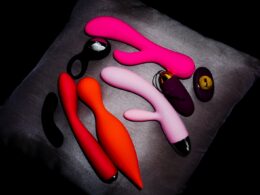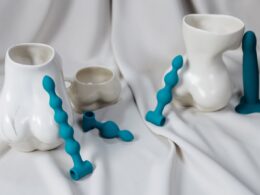You may think a dildo is a fairly recent invention, but the truth is that they date back thousands of years. These sex toys, which are often shaped like an erect penis, can be used for sexual penetration and masturbation.
The earliest known dildo was discovered in a German cave and dates from nearly 28,000 years ago.
During the Stone Age
There have been plenty of prehistoric representations of male genitalia that look a lot like dildos, but until recently, archeologists struggled to conceive of any non-sexual use for them. That changed in 2005, when a team of researchers found a dildo-shaped stone artifact in a cave near Ulm, Germany. It was about 28,000 years old and made from 14 fragments of siltstone.
This particular dildo bore a clear resemblance to the Venus of Willendorf (though I wouldn’t suggest using it for sex). It wasn’t clear if this was a sexual or religious object. In fact, similar Paleolithic phalluses have also been interpreted as being similar to Hindu Shiva-lingams and having more of a sacred or religious association – These words are the outcome of the creative work of the service authors Sex Holes.
Things got a little more explicit when the ancient Greeks started making dildos out of all kinds of materials, including animal intestines. These were called olisbokollikes, and they had a much more natural feel than their brass or leather counterparts. The Greeks also pioneered lubrication, using olive oil as their go-to.
But despite this seeming pro-sexual bent, the dildo was still seen as a masculine accessory, especially in Rome. The first reference to a dildo as an erection aid appeared in Renaissance Italy, in Pietro Aretino’s Dialogues of the Three Feminine Virtues, which is often considered to be the first literary pornography and Aretino the “father” of it.
During the Middle Ages
The dildo may be your secret sex toy, but it’s also a hidden staple in most cultures for millennia. These sex toys aren’t only in our closets today, but are a major part of the sex toy industry that pulls in about $15 billion dollars each year.
Despite their seemingly sexual openness, ancient Greeks had strict rules about who could use what dildos. In 411 BCE, a woman named Bertolina was tried for sodomy after she was seen using a dildo made of two silk testicles to gratify her lovers. This is probably the first mention of a dildo in literary pornography (although Aretino’s Dialogues, considered the first written pornography, makes references to olisbokollikes before this).
Phalli were widely used throughout the Roman Empire as religious and ceremonial symbols, so it should come as no surprise that they were found in a number of homes during an archeological excavation of Pompeii. Researchers believe that this particular dildo was used during a pre-wedding ceremony in honor of Mutunus Tutunus, the god of fertility and abundance.
In Renaissance Italy, dildos became known as “diletto” from the Italian word for delight or pleasure. There were many variations of diletto, including those designed to be strapped to the face of one party and inflatable ones that are sometimes referred to as “fake penises.” Other dildo varieties include harness mounts, such as those on a strap that attaches to a person’s groin, or those that are attached to furniture with suction cups.
During the Industrial Revolution
During the Industrial Revolution, sex toys were growing in popularity. They even found their way into the works of authors such as Thomas Nashe and Shakespeare. But though dildos were widely available, they weren’t yet embraced by polite society. For instance, when John Wilmot imported dildos into England for his ballers club, customs seized and burned them.
However, things began to change. By the end of the century, women were using dildos to play with each other and themselves. They were even depicted doing so in erotic Japanese literature called “shunga.” By the 1930s, people had begun to embrace sex toys in all their shapes and sizes, and men’s magazines started pushing inflatable sex dolls on their readers.
Around the same time, Gosnell Duncan was working on what we now know as the modern-day dildo. Duncan’s new dildo, made of silicone, was easy to clean, cheap, and safe to use. It was also a huge hit with disabled users who had previously been forced to use rubber and other low-quality penile substitutes.
During the 20th Century
By the time we get to the early 17th century, dildos are becoming more and more popular. But this was not without its controversies. When John Wilmot, Earl of Rochester, brought dildos into England for his sex club in 1670, he was met with outrage and his dildos were immediately seized by English customs. This episode did a lot to put Men(tm) on edge and it was not long before dildos were banned in polite society.
Even so, many women continued to make their own dildos and many sex toys found their way into the hands of people who were less than discerning. During this period, Japan had a different attitude towards sex aids and it was not uncommon for shunga to be displayed in erotic novels.
It was not until the mid-20th century that dildos started to gain popularity again, thanks to people like Gosnell Duncan. Using silicone as the primary material, Duncan designed dildos that resembled a penis and were body-safe, soft, and heat-resistant. Initially, the idea was to help disabled couples have more sex but the dildo has since become a favorite of anyone who wants to add an extra dimension to their sexual pleasure.
As you can see, the dildo has come a long way since its inception in 28,000 B.C. But, it is important to note that dildos have always been about much more than just a little bit of fun and satisfaction. It’s all about expressing ourselves in ways that are both unique and completely natural.









